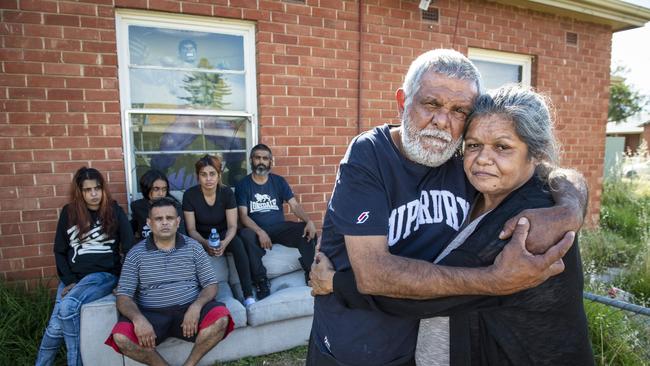Dying Rose | Bombshell documents reveal how Charlene Warrior could have been missing in plain sight
For the first time, police have broken their silence on how Charlene Warrior could have been missing in plain sight – and revealed the startling reason she wasn’t found earlier.
Dying Rose
Don't miss out on the headlines from Dying Rose. Followed categories will be added to My News.
A staggering police report into the disappearance of Charlene Warrior has revealed detectives say a sick neighbour and “aggressive dogs” led to her body not being discovered for two weeks, despite being in plain sight.
For the first time since her disappearance in 2021, Charlene Warrior’s family has received a 51-page report detailing the police investigation into her death – including a final “note”, phone records from the morning she died and details of the search operation.
Charlene Warrior was 21 years old when her body was found mysteriously in a tree in Bute, on South Australia’s Yorke Peninsula, in view of the small town.
Aboriginal and Torres Strait Islander readers are advised that this story contains images and voices of people who have died.
DYING ROSE PODCAST
Listen to the first two episodes here, or find them on the Apple Podcasts app

Her death was ruled to be self-inflicted the morning after her body was discovered, but Charlene’s family immediately feared foul play.
So too, it turns out, did the police.
The report shows that Major Crime detectives were engaged in the investigation, which detectives deemed to be “concerning and potentially suspicious”.
Charlene is one of six Aboriginal women whose cases are being investigated by The Advertiser in Dying Rose, a podcast in which their families ask whether police properly responded to their deaths.
Charlene’s family say this is the first time they have seen the report, prepared by SA Police for the state coroner, which was authored by a detective at the Port Pirie Criminal Investigation Branch.
Search failures
For almost two years after her death, Charlene’s family were left baffled as to how her body could have gone unseen while being in a tree for two weeks – just 100m from where she was last seen and in full view of the search staging site.
Now, they have some answers.
When The Advertiser visited the search site in Bute, it was clear the tree was visible from areas of the site.
But in the report, the detective says Charlene’s “clothing and small stature” meant her body blended in with shedding and fencing.
A series of factors – including a sick paddock owner and neighbour’s aggressive dogs – were also listed as reasons for the apparent search oversight.

The detective says the owner of the sheep paddock adjacent to where Charlene’s body was found was “in fact, in hospital dying of an illness” at the time the search was conducted.
“Unfortunately, it is highly probable this gentleman may have discovered the deceased when checking his stock and paddock well before the date she was eventually discovered,” he said.
Charlene’s body was also found directly behind a local resident’s backyard – but police never searched there, because she had “large dogs”.
“She advised searchers that the dogs may react to them as the dogs don’t like males,” the detective wrote.
“As a result, (the neighbour) placed the dogs in the chicken yard at the rear of the premises. Due to the presence of the dogs, the yard was only visually checked from the inner fence … the deceased body would have been obscured by fence, tree and foliage.”

The report admits failings in the police search, acknowledging that the neighbour’s dogs should have been removed by search personnel and a foot search should have been conducted along the boundary of the paddock where Charlene’s body was found.
“In hindsight, it would have been appropriate for searching personnel to request (the neighbour) remove the dogs to another location … these factors all contributed to the unfortunate outcome of the deceased not being located prior to the date she was found,“ it said.
It also suggests that officers overseeing the operation did not have adequate knowledge of how to co-ordinate SES and CFS personnel, and recommends better training for SA Police officers “before they are involved in a real-life missing persons search”.
Charlene’s mother Alma said it was “outrageous” that search conductors did not ask to move the dogs from the backyard, which could have led to her daughter being found days earlier.
“Well I think that’s a load of crap you know. For them not to go into that house (backyard) and search properly,” Alma said.
“They should’ve done their job properly. That was their job to do that. They do it anywhere else. Why not do it when it comes to a black life?
“I feel that they didn’t search properly. It wasn’t good enough. They could’ve got rid of the dogs. There’s a lot of police out there that could’ve done their job.”
Final farewell
The report revealed that Charlene had edited an image in her phone at 3.13am on September 20 – the date the Coroner ruled to be when she likely died – as a seeming farewell message to her daughter A’methyst.
“Charlene has edited an existing photograph on her mobile phone of herself and (her baby) on 20th of September 2021 at 3.13am to produce what I have concluded to be a suicide message,” the report read.
“That message was: ‘See you in the next life, know mummy always loved you my baby’.”

It also reveals Charlene’s final messages exchanged with her sister, Theresa Newchurch, on September 20.
At 3.36am, Theresa sent Charlene a song accompanied by the words, “it will remind you of me”.
According to the report, the last Facebook message sent from Charlene to Theresa was at 3.38am on September 20, 2021, where Charlene said: “Probably reminded you of me”, and then Theresa responded less than a minute later, “Nah, cause it won’t, you got no money”.
Police say statements and phone records collected following Charlene’s death show she was “unhappy” and “was suffering from undiagnosed mental health conditions”.
The report says that SA Police took statements from 17 civilian witnesses following Charlene’s death, including her mother Alma, father Kent and sister Theresa.
Her family maintains that they had little-to-no contact with police after this.
Nine missing days
The report also addresses the nine missing days between when Theresa said she first reported Charlene missing on September 20 and when police said they received a formal report via the SA Police call centre, from Theresa, on September 29.
However, it still does not provide an explanation for this discrepancy.
“I am unable to find any evidence of any persons reporting Charlene Warrior as missing prior to the 29th of September 2021, or any concerns being raised with authorities,” the detective said.
“If this is the case, there was a nine-day delay in commencing investigations or efforts in an attempt to locate Charlene Warrior.
“I note there has been a strong suggestion within the community that police did not commence searching within an appropriate time frame, with the suggestion that this was due to the fact Charlene Warrior was Indigenous. This is completely unfounded and incorrect.”
Theresa, who adamantly refutes the coroner’s timeline, has provided messages sent before September 29 which state a report had already been made.

The Advertiser first made a request to SA Police about Charlene’s case on November 8, 2021. A subsequent request was made on February 17, 2022, and further requests on September 15, 2022, May 9, 2023, June 9, 2023 and August 21, 2023.
SA Police declined a request from The Advertiser to answer questions directly regarding the search for Charlene, the nine days between the initial missing persons report Charlene’s sister Theresa said she filed and the formal report being received on September 29, and the subsequent investigation.
In a statement, a police spokeswoman said SAPOL had listened to the Warrior family and appreciated and understood their concerns about the circumstances surrounding Charlene’s tragic death.
“Senior SAPOL representatives have met previously with Ms Warrior’s family on a number of occasions and provided updates on the status of the very thorough coronial investigation,” she said.
A subsequent statement from Police Commissioner Grant Stevens said the coroner was satisfied with the evidence presented and has found Charlene’s death was as a result of suicide. The coroner has advised no inquest will be held.
“Unfortunately, due to the nature of suicide, families are often left with unanswerable questions which make the reality of these circumstances difficult to understand or accept,” Mr Stevens said.
‘Appalling’ search
Documents shown to The Advertiser by Charlene’s family indicate that representatives from the Aboriginal Legal Rights Movement pursued a coronial inquest on the family’s behalf – but this was denied by the Coroner.
In a letter explaining that the Coroner had chosen not to open an inquest, a legal representative from the organisation described the “appalling treatment of (Charlene)” as “an oppressed Aboriginal woman treated disgracefully”.
“I attempted to persuade (the Coroner) they should hold an inquest,” he said.
“However … I think (the Coroner) was concerned that the cause of death was really not open to strong dispute and that although the circumstances, particularly relating to the search, were appalling, that was not sufficient to persuade the Coroner that an inquest should be held.”
More Coverage
Originally published as Dying Rose | Bombshell documents reveal how Charlene Warrior could have been missing in plain sight




